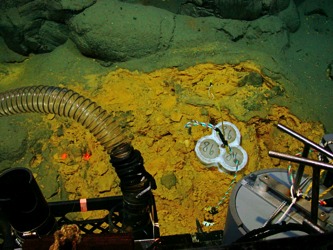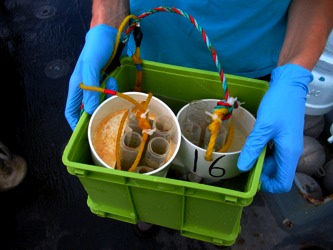FeMO3 Dive Cruise 2008
Report Day 17 -- Wednesday 8 October 2008 -- Volcanic Glass Hunting on Dive J2-374
FeMO3 Dive Cruise 2008 |
| Daily Reports 1 | 2 | 3 | 4 | 5 | 6 | 7 | 8 | 9 | 10 | 11 | 12 | 13 | 14 | 15 | 16 | 17 | 18 |

The deep sea elevator was released from the bottom and arrived at the surface shortly after breakfast. Jason was on deck a short time later and there was a scurry of activity to collect and process bacterial samples, water samples and rock samples from Pele’s Pit.
The morning air was quite clear and the summit of Mauna Loa stood above the clouds. To the right and below the clouds the white plume from the summit crater of Kilauea was visible. Further to the right was just a wisp of steam from lava entering the sea. I would have liked to take a picture including Mauna Loa’s summit and the two steam plumes but the distance between them is so great it is impossible to capture more than one at a time.

Jason was serviced quickly and returned to the deep right after the 4pm shift change. During the day the bioboxes and large ISEA chemistry probe was removed to make room for 5 round rock boxes. The heavy bottom mapping sonar was also removed to give more lifting capacity to Jason for bringing rock samples to the surface. The goal of the new dive (J2-374) is to document rifting and lava flows along the South Rift and collect rock samples that might provide clues to where in the Earth the basalt came from. Evidence from noble gasses such as Helium and Argon suggests that the lava that builds the Hawaiian Island chain has the deepest source known. The study of its composition can tell us about the composition of the deep interior of Earth.
The South Rift was covered with lobate flows surprisingly similar to what form on land when the crust of hard lava breaks open to push out a blob of new molten rock. This is repeated over and over until the overlapping blobs form a network of organic shapes like a pile of intestines from the bowels of the Earth. In some areas there were occasional large mounds that rise 1 or 2 meters above the rest of the lava. This general surface seemed to be wrapped over a series of giant stairs. Jason would climb gently, then rise up a steep slope, cross a gently plateau and rise again. Along the route were seen some solitary corals or sponges and a few anemones.
We stopped to sample some of the black sand that appeared between the lobes of lava, and again to sample glassy rocks. The rocks were so brittle in places that Jason’s claw shattered the smaller ones into pieces the size of plums.
| FeMO3 Cruise Home Page |